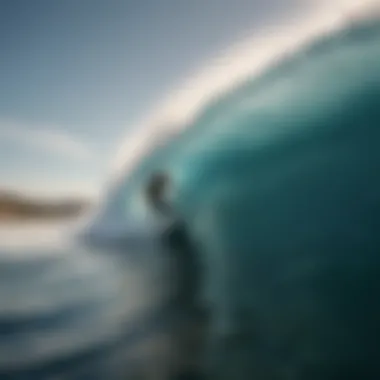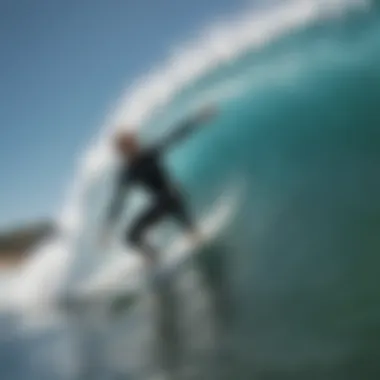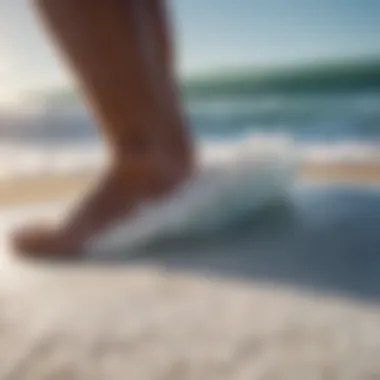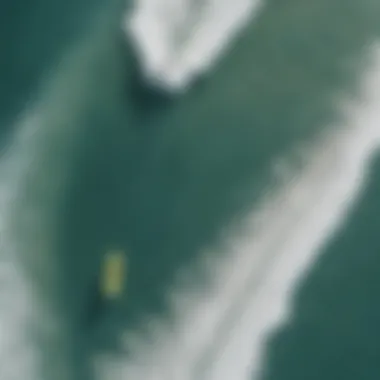Understanding Sea Saltwater: A Guide for Surfboarders


Intro
For those who live for the rush of catching that perfect wave, knowing the ins and outs of sea saltwater isn't just a side note; it’s part and parcel of surfboarding. Saltwater is temperamental—it can change with the tides and seasons, impacting not just how and when we ride but also our overall health, the environment, and surfing culture itself.
This article explores saltwater’s intricate role in surfboarding by unpacking its chemical properties, the benefits and drawbacks it presents, and what that means for surfers today. We won't just skim the surface; we'll dive deep into the elements that shape our experiences in the ocean.
Whether you’re a rookie paddling out for the first time or a veteran riding massive swells, understanding the connection between saltwater and surfboarding can enhance your practice and keep our oceans thriving.
So grab your board, and let's head out into the surf!
Understanding Sea Saltwater
Sea saltwater forms the essence of the surfing experience; it’s not merely a body of water; it's a dynamic environment with complex properties that influence everything from wave formation to surfer health. A thorough understanding of sea saltwater is vital for anyone who embraces the waves. This section aims to dissect its composition, examine its ecological impact, and highlight its significance to the overall surfing experience.
Composition of Sea Saltwater
Chemical structure
The chemical structure of sea saltwater revolves primarily around its main components: sodium chloride, water, and various dissolved substances. Sodium chloride, the most prevalent constituent, enhances the water's density and buoyancy. This characteristic is not just interesting; it directly affects how surfers interact with the ocean. Without it, our beloved surfing wouldn't be the same—the waves could be feeble, and the entire experience would lose its charm. The unique arrangement of molecules in saltwater also affects its physical properties, influencing everything from wave size to surf conditions.
Salinity and its variations
Salinity—the measurement of salt concentration—plays a critical role in shaping the ocean’s personality. Variations in salinity can result from freshwater influxes from rivers, evaporation, and climatic changes. For surfers, understanding salinity is essential as it impacts wave consistency and surf conditions. High salinity levels can lead to denser water, which in turn can create more powerful waves, while lower levels may mean weaker surf. Notably, the taste of salt in the ocean is a telltale sign of these variations, serving as a practical indicator of the current conditions that surfers face.
Trace minerals and their significance
Trace minerals, though present in minute quantities, contribute significantly to the ecological balance of the seawater. Elements like magnesium, potassium, and calcium not only support marine life but also enhance the overall health of the oceanic environment. As surfers ride the waves, they too reap benefits from these minerals. For instance, sea salt is often touted for its purported skin-soothing properties, making saltwater a natural option for those looking to keep their skin healthy while enjoying a surf session. However, it’s crucial to note the potential disadvantages, such as skin irritation for those with allergies or sensitivity to specific minerals.
The Oceanic Ecosystem
Role of saltwater in marine life
Saltwater is the lifeblood of the oceanic ecosystem, influencing where and how marine life thrives. From plankton to massive marine mammals, the saltwater environment fosters an intricate web of relationships. Understanding this dynamic is particularly beneficial for surfers, as a healthy marine ecosystem often correlates with better surf conditions. Clearer waters and thriving ecosystems tend to attract more surfers; it's a win-win for both the ocean and the community. Furthermore, the salinity supports a diverse range of species, ensuring that the ocean remains vibrant and lively.
Coral reefs and biodiversity
Coral reefs, often referred to as the rainforests of the sea, are rich ecosystems that rely heavily on saltwater. These unique ecosystems not only provide shelter for countless marine species but also play a vital role in coastal protection against storms. For surfers, healthy reefs translate to better wave breaks, which attract surf enthusiasts. However, the delicacy of these environments is alarming; pollution and climate change are threatening their existence, which in turn could affect surfing conditions globally. Protecting our reefs is crucial for both the marine ecosystem and the surfing experience.
Impact of temperature and pollution
Temperature changes and pollution sources are two factors significantly affecting the health of saltwater conditions. Rising temperatures can disrupt marine life, resulting in altered habitats that impact wave quality. Pollution, on the other hand, introduces harmful substances into the ocean, posing risks for surfers. Sewage runoff or plastic waste not only endangers aquatic life but also raises health concerns for those who spend time in the water. Understanding these impacts is a step towards responsible surfing and fostering a healthier ocean.
Impacts of Saltwater on Surfing
Understanding the impacts of saltwater on surfing is paramount for both seasoned surfers and newcomers alike. It's not just about catching waves; it encapsulates a whole range of elements that intertwine with surfing conditions, health, and environmental sustainability. Saltwater comes with its own quirks that affect not only the sport but also the surfers' overall experience. The ocean's behavior, the pleasant sensation of salt against our skin, and the climate all play critical roles in shaping surf experiences.
Surf Conditions and Saltwater Dynamics
Wave formation and characteristics
Wave formation is fundamentally tied to how saltwater interacts with wind and the ocean floor. The shape and size of the waves are a direct result of these interactions. For instance, when wind blows over the ocean's surface, it creates ripples that can grow into massive waves under the right conditions. This aspect of wave dynamics is crucial because it determines the quality of surf.


A key characteristic of wave formation is its adaptability; it can vary with the seasons and is influenced by local geography. Notably, point breaks and reef breaks tend to produce cleaner and more defined waves compared to beach breaks, which can be more chaotic. This clean wave formation is often a popular choice for surfers seeking smooth rides and thrilling challenges. However, not all surfers may find themselves at ease with the unpredictability of beach breaks, making wave characteristics a multifaceted consideration during surfing.
Tide effects on surfing spots
The tides significantly change the surf landscape throughout the day. High tide or low tide can either enhance or disrupt the wave quality at specific surfing spots. Surfers need to be aware of these changes as they can make a real difference in performance. When the tide is just right, waves can be at their most powerful and rideable, giving surfers that ideal surge that feels just right under their feet.
A unique feature of tide effects is the timing; knowing when to hit the ocean can mean the difference between an exhilarating session and a lackluster one. Still, it’s not without challenges; tides can sweep in quickly, pulling less experienced surfers into difficulty. Thus, understanding tide patterns becomes an essential part of a surfer’s strategy.
Weather influences
Weather plays a substantial role in surfer experience, determining not only wave conditions but also the general feel of a surfing session. Factors like wind speed, storm patterns, and even the position of high and low-pressure systems can affect wave quality drastically. Storms often create more powerful swells, attracting surfers looking for an adrenaline rush.
A major characteristic of weather's influence is its unpredictability. While experienced surfers can read the signs better than most, sudden changes can catch anyone off guard. This unpredictability adds an intriguing aspect to the sport, wherein a calm day could turn into a surf session filled with unexpected challenges. Riding through different weather conditions showcases the surfers' adaptability and skill, but it can also present serious risks. Awareness is critical for safety as certain weather conditions can prove hazardous.
Physiological Effects on Surfers
Skin and saltwater exposure
Being in saltwater can have both invigorating and detrimental effects on the skin. On one hand, the natural minerals found in seawater may help replenish and rejuvenate skin cells, often making surfers feel more alive after a session. However, prolonged exposure can lead to dryness and irritation, resulting in conditions that no surfer wants to deal with.
The key characteristic here is originality; the saltwater environment promotes a unique relationship with our skin. The rough and gritty interaction with salt can mean both pleasure and pain. Surfers often have to navigate the fine line between enjoying the salt water's benefits and dealing with its harsher realities.
Hydration and performance
Staying hydrated while surfing becomes a critical necessity as saltwater can accelerate dehydration. Even the most enthusiastic surfers can forget about this basic need amid the thrill of the waves. The physiological impact of dehydration can lead to reduced performance on the board, making hydration an essential concern for any water sport aficionado.
Another intriguing aspect is how hydration correlates with endurance and strength. A well-hydrated surfer can maintain better focus and agility, which are paramount for handling unpredictable waves. Understanding hydration's role in performance isn't just a smart choice; it's vital for enhancing one's surfing abilities.
Effects of saltwater on health
The effects of saltwater on overall health can be a double-edged sword. While saltwater can soak up stress, improve moods, and promote healthier skin, there are also concerns. Potential infections from cuts or wounds can be aggravated in saltwater, raising questions about safety in surfing.
Being aware of injuries and how they react with saltwater can make or break a surfing experience. Surfers often must consider these health factors, evaluating the risks versus the restorative qualities of saltwater.
"Understanding saltwater isn't just a surfer's perk; it's a badge of honor in the riding community. The balance between enjoyment and caution becomes a surfer's artful dance."
Learning to manage saltwater interactions becomes integral as surfers find ways to embrace and mitigate the impacts.
All these aspects—surf conditions and dynamics, physiological factors, and health considerations—make clear that saltwater is intricately linked to the surfing lifestyle. By recognizing these relationships, surfers can optimize their experiences while advocating for enhanced ocean stewardship.
Environmental Concerns
In this section, we will discuss Environmental Concerns that are closely tied to the world of surfing and saltwater. These concerns are crucial, as they can influence not only the quality of the surfing experience but also dictate the conditions for future generations of surfers. Understanding these aspects fosters a connection between surfboarders and the ocean, encouraging responsible practices and conservation efforts that aim to preserve this beautiful yet vulnerable environment.
Pollution and Its Impact on Surfing
Sources of Marine Pollution
Marine pollution can come from a multitude of sources, which significantly alters the surfing landscape. Common culprits include industrial runoff, sewage discharge, plastic waste, and oil spills. For surfers, this pollution not only undermines the aesthetic beauty of the waves but also introduces harmful chemicals into their surfing environment. Plastics often entangle marine life, disrupt ecosystems and can even wash up on the beaches, creating hazards for surfers both in and out of the water.
Recognizing these sources helps emphasize the need for clean water initiatives, making it an essential topic in our exploration of saltwater.
Ecological Repercussions


Pollution has various ecological repercussions that ripple through marine ecosystems. Contaminated waters can lead to harmful algal blooms, which choke marine life and diminish biodiversity. Surfers may find themselves in polluted waters, which could result in skin irritations or more serious illnesses.
Understanding these ecological repercussions encourages surfers to advocate for cleaner oceans and participate in initiatives that aim to reduce pollution. The more plaid surfers are on this matter, the better chance we have at preserving surfing environments for everyone.
Safety Concerns for Surfers
Safety is paramount, especially when surfing in polluted waters. Chemical toxins, bacteria, and floating debris pose significant health risks. Skin infections can arise from exposure to contaminated water, and surfboarders may also face hazards from submerged objects hidden beneath the surface. The unpredictability of conditions can exacerbate these risks, making it vital for surfers to be vigilant.
Awareness surrounding safety concerns encourages surfers to be proactive about their health, and importantly, to advocate for better environmental practices within their local communities.
Climate Change and Ocean Dynamics
Effects of Rising Sea Levels
Rising sea levels are an undeniable threat resulting from climate change. As the polar ice caps continue to melt, coastal areas where surfers congregate are at risk. This poses challenges such as increased flooding and erosion, which can alter the very nature of surf spots.
It’s crucial to understand these effects; they encourage conversations around coastal management and protection. The more awareness brought to the issue, the better equipped communities become to adapt and mitigate potential impacts.
Impact on Waves and Surf Spots
Changes in the climate are not just about rising seas; they are also altering wave patterns. Stronger storms and unpredictable weather can lead to more intense waves or, conversely, flat days where there are no suitable conditions for surfing. For dedicated surfers, this means adapting their expectations and positioning themselves in different locations to chase consistent swells.
These impacts necessitate flexibility and an openness to change, thus reshaping how surfers approach their sport and select prime surfing locations.
Long-term Predictions for Surfing Environments
Looking ahead, long-term predictions are essential to gauge how surfing will evolve. Environmental shifts can lead to scenarios where some surf spots may disappear or become less viable for surfing, while new locations could rise to prominence.
By keeping an eye on these predictions, surfers can strategize accordingly. Whether it’s holding onto popular spots or exploring uncharted waters, understanding these dynamics can be the key to surviving and thriving as a surfing community.
"If we don’t adapt with the times, our beloved waves may simply wash away."
In sum, the environmental concerns surrounding saltwater offer a robust framework for understanding the interaction between surfers and their cherished ocean. By recognizing pollution, climate change, and the safety issues that arise, surfers can engage in more responsible practices and ensure the sustenance of their surf culture for generations to come.
Sustainable Surfing Practices
Sustainable surfing practices are like the lifeblood of the surf culture around the globe. The essence goes beyond just riding waves; it’s about fostering a respectful bond between surfers and the ocean. When surfers embrace sustainability, they not only enhance their own experience but also contribute positively to marine health. This section digs into vital elements, benefits, and considerations that make sustainability not just a choice, but a necessity for all surfboarders.
Community Engagement in Conservation
Local cleanup initiatives
Local cleanup initiatives serve as the cornerstone of community engagement in ocean conservation. They bring together surfers, locals, and enthusiasts who share a common goal—keeping beaches pristine. These gatherings are often organized around surf competitions or community events. With everyone chipping in, it becomes a celebration rather than a chore.
A key characteristic of these initiatives is their ability to forge connections. Surfers meet like-minded individuals, strengthening the community while giving back to Mother Nature. The unique feature of local cleanups is the direct impact they have on immediate surf locations, elevating water quality and beach aesthetics. Although the project may seem small-scale, the collective effort can be substantial, showing that every little bit counts. Still, coordination and commitment might be challenges that require attention.
Surfboards and eco-friendly materials
The surfboard itself is another axis on which sustainability spins. Switching to eco-friendly materials yields significant environmental benefits. Traditional surfboards often use polyurethane foam, which is not biodegradable. On the flip side, boards made with sustainable materials like bio-resin or recycled foam minimize environmental impact.
A major point is that eco-friendly boards don’t sacrifice performance. Many surfers now are voting with their wallets, choosing sustainable options that perform just as well as their conventional counterparts. A unique feature of these boards is an increased lifespan due to the high-quality materials used. However, one must bear in mind that these options might come at a slightly higher price, making affordability a topic worth pondering.
Educating surfers about marine protection


Educating surfers about marine protection can be seen as planting the seeds for future sustainability. Knowledge empowers surfers to make informed choices that can contribute to healthier oceans. Workshops, written guides, and community talks play a vital role here. When surfers grasp the significance of clean oceans, they are likely to advocate for improved practices, spreading the word further than one may expect.
One of the highlights of educational efforts is the sense of responsibility that flows from awareness. Surfers become ambassadors for their local ecosystems. A unique aspect of this is the duality of learning; surfers better their own experiences while supporting marine environments. On the downside, the challenge lies in ensuring that educational programs reach enough people to create significant change.
Creating Responsible Surfing Habits
Minimizing footprints on beaches
Minimizing footprints on beaches is a simple yet effective approach to sustainability. Every step taken can impact fragile ecosystems. The practice includes not only picking up trash but also recognizing the delicate balance of nature and staying on established paths to avoid damaging vegetation.
The key characteristic here is consciousness. Surfers who are mindful of their footprints are more likely to carry that awareness into their daily lives—extending beyond the beach. The unique feature of this approach is that it can become second nature; little adjustments can yield monumental effects over time, transforming entire surfing communities into stewards of the environment.
Respecting wildlife and habitats
Respecting wildlife and habitats is paramount when considering sustainable surfing practices. The ocean is home to numerous species that depend on healthy ecosystems. Surfers often share their domains with marine life, making it essential to understand their presence and importance.
One significant aspect is the recognition of the interconnectedness of all life forms. When surfers understand that disturbing wildlife can lead to broader ecological issues, they become more aware and, ultimately, more cautious. A unique feature of this practice is that it fosters a culture of respect and appreciation, encouraging surfers to protect not only their sport but also the marine environments they cherish. Nonetheless, the challenge lies in instilling this respect in a manner that becomes instinctual rather than a burden.
Promoting awareness among fellow surfers
Promoting awareness among fellow surfers can be seen as creating ripples that extend far beyond individuals. The surf culture is rich with stories and traditions, making it an ideal platform for spreading awareness about ocean health.
A key characteristic of fostering awareness is community spirit. Surfers who share tips, stories, and resources contribute to a more informed group. The unique feature of this approach is its power to inspire collective action; one informed surfer can influence many others, amplifying the impact. However, the challenge is ensuring everyone remains engaged and interested over time, avoiding the pitfalls of complacency.
In essence, sustainable surfing practices are not just about reducing the ecological footprint but fostering a deep respect and love for the ocean that drives the surfing experience.
Cultural Reflections on Saltwater in Surfing
Cultural reflections on saltwater and surfing weave an intricate narrative that underscores how deeply surf culture is entwined with the essence of the ocean. Saltwater isn't just a medium for riding waves; it symbolizes life, spirit, and community in the surfing world. This section delves into the historical significance of surfing, the impact of location on styles, and the traditions that embody the rhythm of surf communities. By exploring these aspects, we can appreciate how surfing represents more than a sport—it reflects a lifestyle and an unspoken bond between surfers and the ocean.
Historical Significance of Surfing
Origins of surf culture
The roots of surf culture trace back centuries, particularly to the Polynesian islands, where it was more than just sport but a cultural ritual. Surfing was tied to the ocean's power, with wali ceremonies often held to honor the water gods. The unique allure of this pastime combined recreation with spirituality, marking surfing as a cornerstone of native traditions. This historical lens offers insight into how modern surfing respects its roots, promoting a sense of karma—what you give to the ocean will return to you.
Influence of location on surfing styles
Location plays a critical role in shaping surfing styles. Take Hawaii, for instance—its big, powerful waves redefine the sport. In contrast, the mellow breaks of California attract a different kind of ride and vibe. Each locale contributes its distinct flavor to the surfing experience, teaching surfers to adapt, learn, and ultimately respect the waters they inhabit. This aspect fosters a cultural exchange where surfboarders not only hone their skills but also carry the identity of their locations into the surf culture.
Traditions and rituals in surfing communities
Rituals are the lifeblood of surf communities. Be it the dawn patrol or the full moon gatherings, these practices unify surfers and offer a deeper appreciation of shared experiences. Traditions such as the board blessing—which is when surfers honor their surfboards before hitting the water—overlay a layer of gratitude that permeates the surfing community. These moments underscore the respect surfers have toward the ocean and each other, creating an enduring culture that both uplifts and binds.
Modern Interpretations and Innovations
Evolution of surfboard design
The evolution of surfboard design is a testament to how the sport innovates with time while maintaining ties to its heritage. Earlier boards, made from wood, have transformed into light, maneuverable designs crafted from high-tech materials such as epoxy or polyurethane. This change not only enhances performance but also signals a shift in how surfers engage with the ocean—turning riding into a blend of art and technology, increasing the potential for new styles and techniques.
Impact of technology on performance
As technology seeps into the surfing culture, performance has soared to previously unimaginable heights. From wave forecasting apps to performance tracking devices, surfers can analyze their rides like never before. This tailored approach enhances individual skill by providing insights into ocean conditions and personal metrics. However, it raises questions about dependency on technology versus the intangible connection surfers hold with nature.
Trends in surfing lifestyles and diversity
Modern surfing lifestyles reflect incredible diversity, embracing not just the thrill of riding waves, but also a sustainable relationship with the ocean. Surfers are becoming increasingly aware of environmental impacts, advocating for preservation and responsible practices. This trend not only inclusively broadens who can identify as a surfer but also instills a sense of duty to protect these beloved environments—aligning the sporting spirit with ecological awareness.
"Surfing is not just a sport; it’s a way to connect with nature and reside in harmony with it."















